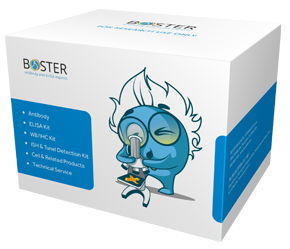Product Info Summary
| SKU: | BM2003 |
|---|---|
| Size: | 0.5ml |
| Reactive Species: | Human |
| Application: | Flow Cytometry, IF |
Product info
Product Overview
| Product Name | Mouse Anti-Human IgG (H+L) Secondary Antibody, FITC Conjugate |
|---|---|
| Synonyms | FITC-conjugated Mouse Anti-Human IgG; Mouse Anti-Human IgG-FITC Secondary Antibody; Fluorescein-labeled Mouse Anti-Human IgG Secondary Antibody |
| Description | Mouse Anti-Human IgG (H+L) Secondary Antibody, FITC Conjugate, for detection, localization and quantification of target proteins in a sample via indirect immunofluorescence in IHC-P, IHC-F, ICC, or FCM. |
| Reagent Type | Fluorophore-conjugated secondary antibody |
| Conjugate | FITC |
| Host | Mouse |
| Target Species | Human |
| Antibody Class | IgG |
| Clonality | Polyclonal |
| Immunogen | Whole molecule human IgG |
| Purification | Immunoaffinity chromatography |
| Specificity | Human IgG specific; No cross-reactivity with rabbit/goat/bovine IgG |
| Form Supplied | Liquid, concentrated buffered stock solution |
| Formulation | 0.5 mg HRP-conjugated secondary antibody
0.01 M PBS (PH 7.4) 5 mg/mL BSA 50% glycerol |
| Pack Size | 0.5 ml |
| Concentration | 1 mg/ml |
| Application | IF, Flow Cytometry *Our Boster Guarantee covers the use of this product in the above marked tested applications. |
| Storage | At -20˚C for one year from date of receipt. Avoid repeated freezing and thawing. Protect from light. |
| Precautions | FOR RESEARCH USE ONLY. NOT FOR DIAGNOSTIC OR CLINICAL USE |
Assay Information
| Sample Type | Human primary-antibody-probed Single cell suspension, Formalin-fixed paraffin-embedded (FFPE) tissue sections, Thawed frozen samples (IHC-F) |
|---|---|
| Assay Type | Immunoanalytical |
| Assay Purpose | Protein detection/quantification |
| Technique | Immunofluorescence |
| Equipment Needed | Excitation light source; Filter set and detector: fluorescence microscope (can be combined with confocal microscope), fluorescence plate-reader, flow cytometer, or cell sorter |
Main Advantages
| Specific | High signal-to-noise ratio |
|---|---|
| High Signal Amplification | Multiple secondary antibodies can bind to a single primary antibody;Multiple FITC molecules bind to a single secondary antibody |
| Fast | Fewer number of processing steps - no need for adding a substrate; Less optimization required compared to enzymatic detection; Generates strong signals in a relatively short time span; Fluorescence can be observed directly |
| Quantifieable | Allows quantification of detected signal |
| Easy to Use | Supplied in a workable liquid format |
| Multiplex Compatibility | Colocalization studies (multiple antigens concurrent detection), even in close proximity: using primary antibodies from different host species for simultaneous detection by fluorophore-conjugated secondary antibodies;using multiple differently colored fluorophores in the same experiment for targets differentiation |
Background
Most commonly, secondary antibodies are generated by immunizing the host animal with a pooled population of immunoglobulins from the target species. The host antiserum is then purified through immunoaffinity chromatography to remove all host serum proteins, except the specific antibody of interest. Purified secondary antibodies are further solid phase adsorbed with other species serum proteins to minimize cross-reactivity in tissue or cell preparations, and are then modified with antibody fragmentation, label conjugation, etc., to generate highly specific reagents. Secondary antibodies can be conjugated to a large number of labels, including enzymes, biotin, and fluorescent dyes/proteins. Here, the antibody provides the specificity to locate the protein of interest, and the label generates a detectable signal. The label of choice depends upon the experimental application.
Immunofluorescence is a technique used for light microscopy with a fluorescence microscope which utilizes fluorescent dyes as reporters. It is being employed in a variety of applications such as cellular imaging and flow cytometry and is commonly used to visualize the distribution of target molecules through a sample, to detect protein location and activation, to identify protein complex formation and conformational changes, to monitor biological processes in vivo.
Fluorescent dyes (also known as fluorochromes, fluorophores, or simply fluors) are molecules that can absorb light of a specific energy and wavelength, thereby undergoing excitation, and then re-emit it at a lower energy and longer wavelength upon returning to the ground state.
Product Images
Validation Images & Assay Conditions

Click image to see more details
Boster Kit Box
Specific Publications For BM2003
Hello CJ!
BM2003 has been cited in 2 publications:
*The publications in this section are manually curated by our staff scientists. They may differ from Bioz's machine gathered results. Both are accurate. If you find a publication citing this product but is missing from this list, please let us know we will issue you a thank-you coupon.
Chen J,Wu D,Dong Z,Chen A,Liu S.The expression and role of glycolysis-associated molecules in infantile hemangioma.Life Sci.2020 Oct 15;259:118215.doi:10.1016/j.lfs.2020.118215.Epub 2020 Aug 5.PMID:32768579.
Species: Human
BM2003 usage in article: APP:IF, SAMPLE:HEMECS AND HUVECS, DILUTION:1:50
Role of Jagged1/STAT 3 signalling in platinum‐resistant ovarian cancer Jiang Yang, et al. J Cell Mol Med. 2019 Jun; 23(6): 4005–4018. Published online 2019 Apr 16. doi: 10.1111/jcmm.14286
Customer Reviews
Have you used Mouse Anti-Human IgG (H+L) Secondary Antibody, FITC Conjugated?
Submit a review and receive an Amazon gift card.
- $30 for a review with an image
0 Reviews For Mouse Anti-Human IgG (H+L) Secondary Antibody, FITC Conjugated
Customer Q&As
Have a question?
Find answers in Q&As, reviews.
Can't find your answer?
Submit your question


